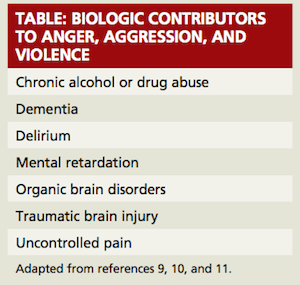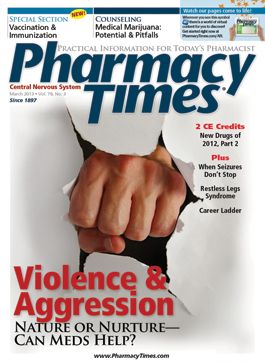Violence & Aggression: Nature or Nurture-Can Meds Help?
The pharmacist can play an important role in the treatment of patients with anger management problems.
The pharmacist can play an important role in the treatment of patients with anger management problems.
Violence and aggression take multiple forms, many of which are covered in the nightly news. Murder, rape, familial abuse, bullying, workplace hostility, armed robbery—all of these are societal problems with far-reaching repercussions. Their roots are in uncontrolled anger and impaired impulse control. Most of us recognize simmering aggression by a person’s prolonged eye contact, belligerent posture, loud voice, and threatening gestures.
Often it seems as if the incidence and magnitude of societal violence and aggression are escalating. Experts estimate that up to 25% of youths have aggressive problems leading to poor academic performance, social isolation, legal problems, and drug or alcohol problems.1-3 Violence in adults is hard to track because it occurs in many forms and places.
Anger is a necessary and innate drive. It’s critical as a constructive defense mechanism when real threats or provocations occur. It becomes maladaptive, destructive aggression when people direct their anger at self or others for reasons other than preservation. Unnecessarily or pathologically aggressive people trample on others’ rights, invade personal space, and use physical or verbal violence to promote their own interests. These people often lack self-confidence or self-esteem, using force to hide insecurities and vulnerabilities.4,5
Pharmacists need to work with the clinical team and consult the professional literature to provide the most effective treatments in violence and aggression.
Nature or Nurture?
What causes aggression and violence? It depends. Some experts consider aggression the consequence of environment, and others believe there are biologic causes. In reality, each patient’s unique psychological makeup, underlying biology, and symptom constellation will differ.
To understand how patients handle anger, psychologists emphasize the importance of predisposing developmental or life experiences. Severe emotional deprivation, abuse, exposure to violence, or overt rejection in formative years may create self-esteem and trust defects. Consequently, patients may have a limited capacity to identify nonviolent coping mechanisms. If individuals have neurologic deficits, the propensity toward violence increases.4,5
Sociologists often consider aggression to be a learned behavior, acquired through faulty socialization. Many authors cite frustration or unmet needs as a key stimulant for violence.4,5 Some individuals find aggression personally reinforcing if they achieve goals or if it makes them feel important, powerful, and in control. Others see role models using aggression, infer that violence is acceptable, and imitate that behavior. Violence in aggressive sports and portrayed in media reinforce aggression. Thus, some people learn to use violence to define their social status.4-6
Researchers believe that 3 areas of the brain—the limbic system, the frontal lobes, and the hypothalamus—are involved in aggression. Neurotransmitters also have a role based on findings that suicidal and homicidal people have lower than average 5-HIAA levels, indicating depressed serotonin levels. Dopamine, norepinephrine, acetylcholine, and gamma-aminobutyric acid also seem to affect impulsivity and anger expression.7
Numerous psychiatric diagnoses may include a component of aggression, including attention-deficit/hyperactivity disorders, bipolar disorder, borderline personality disorder, conduct disorder, depression, oppositional defiant disorder, and schizophrenia. Public perception of people with psychiatric diagnoses is that they are more aggressive and violent than they actually are. There is considerable stigma in the general population.8 Proponents of the biologic theory of pathologic aggression cite numerous physical conditions as causes or contributors to pathologic aggression (Table9-11).

Medications can also cause aggression. Ironically, the same medications that cause aggression are the very ones used to treat impulse control and aggression—benzodiazepines, some anticonvulsants, atypical antipsychotics, and some antidepressants. Paradoxical excitation has been reported with some drugs that cause disinhibition, especially benzodiazepines and alcohol.12,13 Of note, the antiepileptics levetiracetam, lamotrigine, and gabapentin can improve cognition in epileptic patients, but can cause “release phenomena.” In this situation, the patient feels good enough to misbehave as treatment works.14,15 If patients develop anger management problems when a new drug is started, suspect the drug.
Treatments
Patients with anger management issues and histories of violence are often referred for assessment and treatment. When they are referred, clinicians need to be cautious and ensure the safety of all who come in contact with that patient. Clinicians also need to protect potential victims if the patient verbalizes threats. Clinicians who work in psychiatric settings usually have basic protocols to recognize and prevent violence.
If the patient has an untreated underlying condition (eg, pain, dementia, depression, recent stroke) that may cause aggression, addressing this condition is a first step.16 Concurrent counseling or psychotherapy are also sensible. When medical interventions, counseling, and psychotherapy do not achieve reasonable goals, adjunctive prescription medication that targets aggression may be useful. Medication is never a first or single solution.
Several factors influence drug selection: availability of an intravenous or intramuscular injection in acute and emergency situations, speed of onset, demonstrated effectiveness in clinical research, and the patient’s previous history of response.
Conclusion
This article provides a general overview of aggression and violence and the growing body of literature that indicates this complex psychosocial-biologic manifestation may be a symptom constellation amenable to medical intervention and drug treatment. Specific doses and treatment durations have been omitted for a number of reasons. First, each patient will need a unique treatment plan based on his or her clinical presentation and comorbidities.
Second, the patient’s age will dictate dosing—the elderly typically need lower doses and use of any of these agents in younger children must be carefully scrutinized. Third, when prescription medication is used for violence and aggression, clinicians need to monitor patients carefully and make adjustments or discontinue medication as necessary. Last, violence may be unpredictable or a somewhat expected response to known triggers, with each situation calling for different interventions.
Ms. Wick is a visiting professor at the University of Connecticut School of Pharmacy and a freelance writer from Virginia.
References
- Loeber R, Farrington DP, eds. Child delinquents: development, intervention, and service needs. Thousand Oaks, CA: SAGE Publications; 2001.
- Webster-Stratton C, Hammond M. Conduct problems and level of social competence in Head Start children: prevalence, pervasiveness, and associated risk factors. Clin Child Fam Psychol Rev. 1998;1:101-124.
- Campbell M, Malone RP. Mental retardation and psychiatric disorders. Hosp Community Psychiatry. 1991;42:374-379.
- Viding E. On the nature and nurture of antisocial behavior and violence. Ann N Y Acad Sci. 2004;1036:267-277.
- Reif A, Rösler M, Freitag CM, et al. Nature and nurture predispose to violent behavior: serotonergic genes and adverse childhood environment. Neuropsychopharmacology. 2007;32:2375-2383.
- Council on Communications and Media. From the American Academy of Pediatrics: policy statement--media violence. Pediatrics. 2009;124:1495-1503.
- Comai S, Tau M, Pavlovic Z, Gobbi G. The psychopharmacology of aggressive behavior: a translational approach: part 2: clinical studies using atypical antipsychotics, anticonvulsants, and lithium. J Clin Psychopharmacol. 2012;32:237-260.
- Gostin LO. “Old” and “new” institutions for persons with mental illness: treatment, punishment or preventive confinement? Public Health. 2008;122:906-913.
- Davies RC, Williams WH, Hinder D, Burgess CN, Mounce LT. Self-reported traumatic brain injury and postconcussion symptoms in incarcerated youth. J Head Trauma Rehabil. 2012;27:E21-E27.
- Fleminger S, Greenwood RJ, Oliver DL. Pharmacological management for agitation and aggression in people with acquired brain injury. Cochrane Database Syst Rev. 2006;18:CD003299.
- Afifi TO, Henriksen CA, Asmundson GJ, Sareen J. Victimization and perpetration of intimate partner violence and substance use disorders in a nationally representative sample. J Nerv Ment Dis. 2012;200:684-691.
- Senninger JL, Laxenaire M. [Violent paradoxal reactions secondary to the use of benzodiazepines]. Ann Med Psychol (Paris). 1995;153:278-281.
- Ashton H. Guidelines for the rational use of benzodiazepines: when and what to use. Drugs. 1994;48:25-40.
- Dinkelacker V, Dietl T, Widman G, et al. Aggressive behavior of epilepsy patients in the course of levetiracetam add-on therapy: report of 33 mild to severe cases. Epilepsy Behav. 2003;4:537-547.
- Besag FM. Behavioural effects of the new anticonvulsants. Drug Saf. 2001;24:513-536.
- Bradford A, Shrestha S, Snow AL, et al. Managing pain to prevent aggression in people with dementia: a nonpharmacologic intervention. Am J Alzheimers Dis Other Demen. 2012;27:41-47.
- Pangilinan PH, Giacoletti-Argento A, Shellhaas R, Hurvitz EA, Hornyak JE. Neuropharmacology in pediatric brain injury: a review. PM R. 2010;2:1127-1140.
- Levy M, Berson A, Cook T, et al. Treatment of agitation following traumatic brain injury: a review of the literature. Neuro Rehabilitation. 2005;20:279-306.
- Citrome L, Volavka J. Pharmacological management of acute and persistent aggression in forensic psychiatry settings. CNS Drugs. 2011;25:1009-1021.
- Yeh YC, Ouyang WC. Mood stabilizers for the treatment of behavioral and psychological symptoms of dementia: an update review. Kaohsiung J Med Sci. 2012;28:185-193.
- Humble F, Berk M. Pharmacological management of aggression and violence. Hum Psychopharmacol. 2003;18:423-436.
- Látalová K, Prasko J. Aggression in borderline personality disorder. Psychiatr Q. 2010;81:239-251.
- Farrer TJ, Frost RB, Hedges DW. Prevalence of traumatic brain injury in intimate partner violence offenders compared to the general population: a meta-analysis. Trauma Violence Abuse. 2012;13:77-82.
- Saoût V, Gambart G, Leguay D, Ferrapie AL, Launay C, Richard I. Aggressive behavior after traumatic brain injury. Ann Phys Rehabil Med. 2011;54:259-269.

